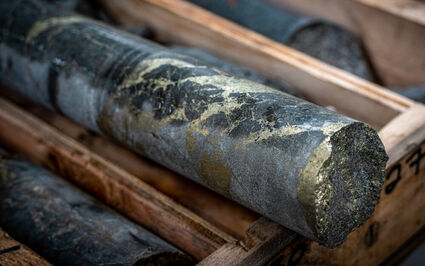REDCHRIS - DEPOSIT Page 65 - A property wide aeromagnetic survey was done in the fall, and field crews ran extensive proton ground magnetometer surveys over the Titan grid and throughout the Todagain Plateau. Geological mapping and prospecting led to some
important map revisions Page 67 - Geo Map - shows RedChris is indeed in the Stinkina assemblage host rocks.
what does Hawkeye have on Railway ?
Hello.
LINK - https://www.google.com/url?sa=t&rct=j&q=&esrc=s&source=web&cd=&ved=2ahUKEwihpuSNx4n0AhUUlWoFHZWoC50QFnoECAUQAQ&url=https%3A%2F%2Fimperialmetals.com%2Fassets%2Fdocs%2F2012-Red-Chris-43-101-Report.pdf&usg=AOvVaw2shf5extLdG5ILCBGAblpP In other reports, two deposit style is acknowledged.
Porphyry
Deep hydeothermal.
If we examine the porphyry aspect - mineralization begins as shallow as,
6.7 meters down....
April 2010 - https://www.imperialmetals.com/for-our-shareholders/press-releases/red-chris-drilling-continues-to-yield-long-intercepts-of-copper-gold-mineralization
Separating the two kinds of deposits, porphyry overlapping the ( got lucky ) hydrothermal benieth, makes one wonder... what would one see on an, EM survey ?
What initially caught Imperials eye on a survey in which to further their exploration ?
Yes... i'd love ot see the original surveys inwhichto compare the resistivities to compare with other nearby juniors.
Do i think the hydrothermal depsoit at depth contributed to the porphyry ?
Nope. I rather think... the porphyry came in, from elesewhere.
Loose, tills from surrounding regions. A mixed assemblage, overlapped the got lucky hydrothermal depoist below.
So, where should a junior be searching - looking for same attributes as Red chris ?
I would say....
match the hatch.. ( pic below ) Look for another porphyry style depoist, reweld.
Match the - grey porphyry ores - not the deep drilled cores that show an entirely different geology. Distinguishing between these two will assist acompetitor junior all the more.
Where i find most juniors seeking is... looking for that iron mag hot spot,
Yet... if we examine the chalcopyrite characteristics - chalcopyrite is not truly magnetic.
So... why hint or focus on the - high mag anomlaies ?
Chalcopyrite is considered - paramagnetic -
Chalcopyrite is considered a mineral of weak paramagnetic properties having a specific magnetic susceptibility of 0.8–4.5 × 10−12 m3/kg [17]. ... Its crystal structure is tetragonal, with the magnetic moment of the iron atoms and sulphur atoms being opposed and aligned parallel to the c-axis. So, what would be the best survey map to use t ofind copper deposits ?
I would say... electrical resistivity.
Scrap the mags.
Copper, zincs, tins, silver, gold, are all nonmagnetic.
And if chalocpyrite is considered not a true magnetic - then... why seek out the red pink mag zones ? One should be looking for a deposit that has been already converted - whereas the iron has given up it's copper - right ?
Throw in your K feldspars, clays, ilites, and now you have a salt factor whereas al lthe more charge is apparent. Yup... electrical resistivities would fair better than, mags.
Cheers....
MATCH THE HATCH -
LOOSE PORPHYRY TILLS THAT HOST THISKIND OF ORE....
OR, RECONSOLODATED ORES ( REWELD ) THAT ALSO LOOK LIKE THIS....

RAILWAY, clims appear to have grey looking soils.
Searching for this kind of ore would be the ticket.
Perhaps Hawk can ask their geophysics company to elborate on better surveys that actually expand on the surrounding areas rather than - isolate - survey zones that inhibit a person from better understanding the surrounding geology and it's interactions.
One won't be able to understand the electrical resistivities with such small zonations.
Cheers....